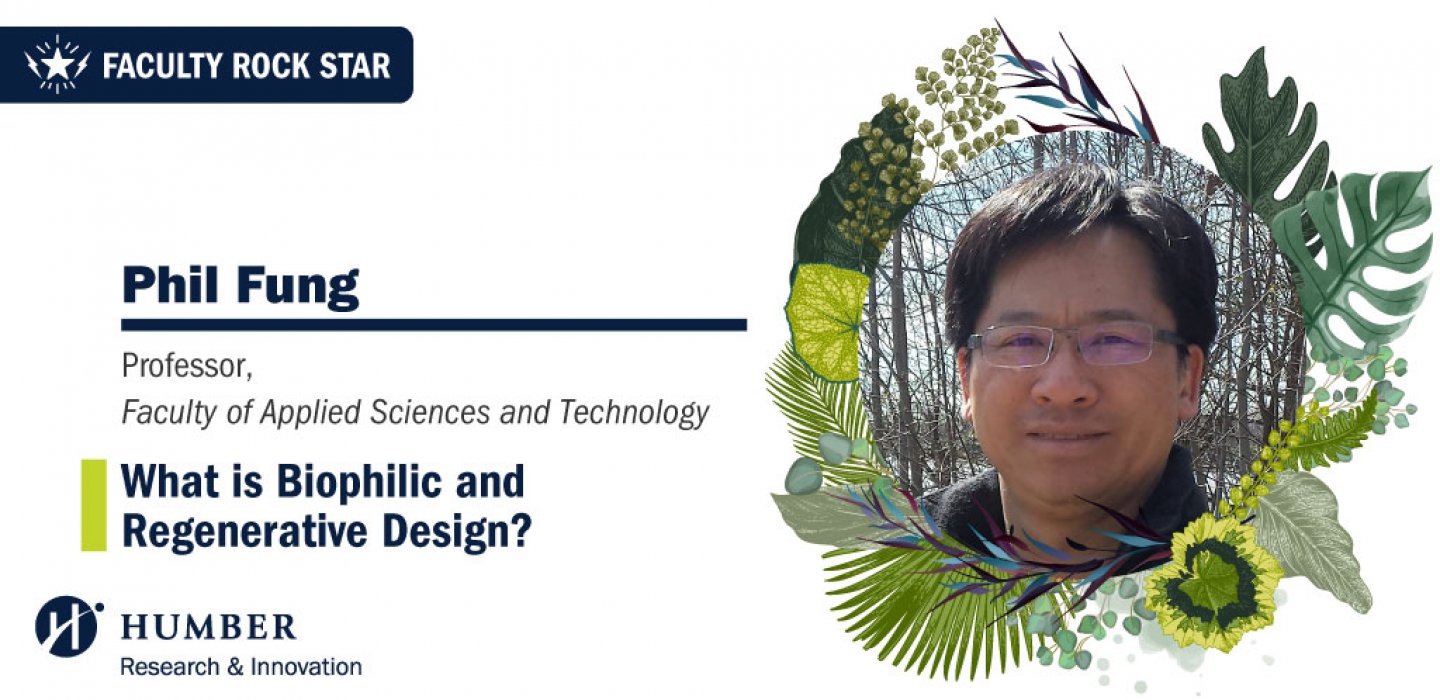Faculty Rock Star: Phil Fung
Biophilic Design: Biophilia | Biomimetics | Regenerative Design
Mother Earth keeps on giving, providing all living beings with efficient and vibrant ecosystems. Over 3.8 billion years of resiliency, adaptation, endurance and an unparalleled capacity to bounce back from calamity–it is something to aspire to–it is an ecosystem that we need to protect and give back to.
“Treat the Earth well; it was not given to you by your parents; it was loaned to you by your children. We do not inherit the Earth from our Ancestors; we borrow it from our Children.” – Ancient First Nations Proverb
Nature! Taking a mindful walk in a garden or by the lake, swimming in the expansiveness of our oceans and seas, listening to the sounds of nature, walking our pets, singing around a bonfire, and the laughter of children playing brings about a healing sense of ease and weightlessness. We are assured you can relate to that feeling. On a long hard day, have you not found solace connecting with plants and animals?
At Humber’s Office of Research & Innovation (ORI), we are constantly looking for ways to direct the impacts of research and innovation where it is most needed. Biophilia, not a new term, has come up more and more in our discussions lately. We had the opportunity to talk to Humber’s Biophilic Expert, Professor Phil Fung, at length about his urgent appeal to focus on bio-inspired and regenerative design.
Humber College Leads the Conversation
Phil reminds us that Humber is truly one of a kind! Did you know that, in Fall 2008, Humber College was the foremost institution to take the initiative to offer an advanced diploma program on Sustainable Energy and Building Technology (SEBT). In Fall 2012, Humber College nurtured Phil’s vision by offering a Bio-inspired Buildings Design course. He prides, “Not just a course but an entire program; that is a huge achievement, and I’m thankful to Humber College.”
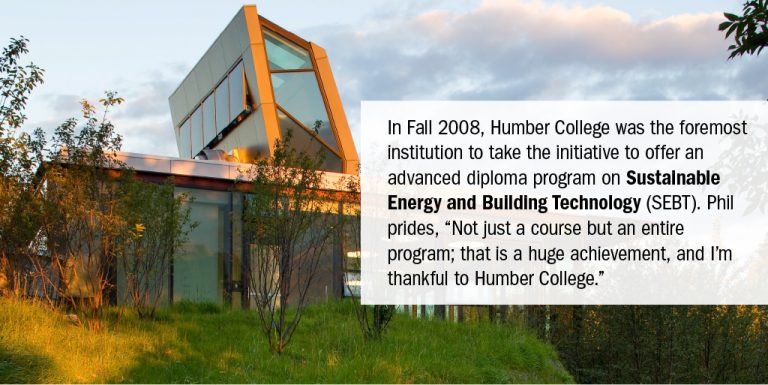
What is Bio-inspired Design? It is Nature-inspired Design.
Bio-inspired design is an emerging and promising design approach that utilizes and optimizes the form and functioning of nature. Design that takes into consideration the magical connections humans have with nature by incorporating living walls into building design for example, by optimizing patients’ recovery in hospitals–in a study conducted by Khan et al. (2008), researchers found that having a window with a nature view resulted in a 1.6 times faster heart rate recovery from low-level stress (similar to the amount experienced working in an office), compared to seeing a nature view on a plasma screen or no view at all.
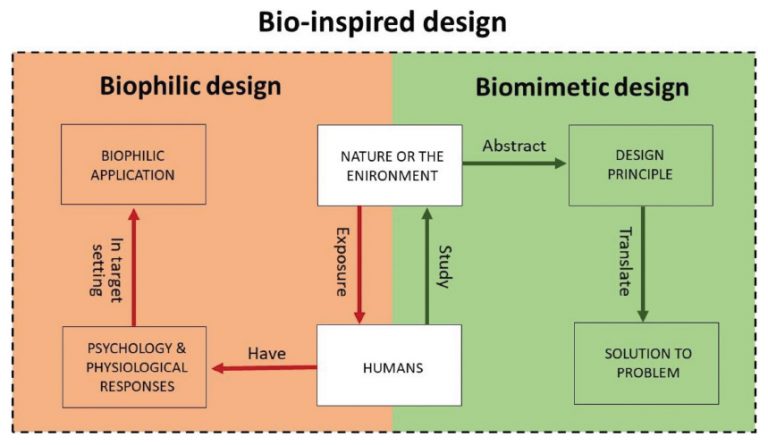
Biophilic design, for instance, is motivated to reproduce the beneficial effects of exposure to nature (e.g., plants, scenery) on human wellbeing
Biomimetic design, in contrast, is motivated to translate the mechanisms of nature into solutions to various problems from engineering to medical sciences.
In our discussion with Phil, we learnt that what ties these approaches together is that the study and thoughtful application of nature is a basis for improving technology, sustainability and human wellbeing.
How did Phil get so passionately driven to this?
“I was trained as an engineer, and I have been working with sustainable building design since the early 2000s. I’m LEED® certified, and I’ve worked closely with organizations that enable buildings to get certified. However, at some point, I stopped and asked myself, “What is a sustainable building? What is a green building?” I was driven to begin my own research and find answers to these questions. This is how my journey with biophilia and biomimicry began. I pondered if only we could learn from nature. Why is it so hard to realize how our wellbeing is directly associated with nature?” – Phil Fung

What is Biophilia?
The word Biophilia comes from the Greek bios meaning life, and philia, meaning love.
In 1964, Social Psychologist Erich Fromm coined the term “biophilia” as a way of describing the innate attraction to processes of life and growth and the impulse to love life, stating, “Biophilia is the passionate love of life and of all that is alive.” In 1984, the concept of “biophilia” was popularized by a renowned biologist and University Research Professor Emeritus at Harvard E.O. Wilson in his book Biophilia.
“Biophilia, if it exists, and I believe it exists, is the innately emotional affiliation of human beings to other living organisms. Biophilia: the innate pleasure from living abundance and diversity as manifested by the human impulse to imitate Nature with gardens. The natural world is the refuge of the spirit, remote, static, richer even than human imagination.” – E.O. Wilson
Phil thoughtfully explores the topic of an active approach to biophilia–get residents of a building involved in the care of plants, living walls and water elements, introduce biophilia in classrooms and promote engagement with students to observe learning outcomes, encourage corporate trips to farms, even indoor farms. The emotional attribution to nature is being studied on as young as 5-year-olds.
Did you know that a ‘Nature Therapy’ program is being offered as a medical prescription to Canadians, where healthcare providers can write a prescription that advises patients to get out into nature, whether walking or biking, for at least two hours a week and then track their progress at follow up appointments!
There is an emergence of a global movement, new and creative ways that cities are restoring, growing and connecting with nature and the current status and trajectory of a new global Biophilic Cities Network, launched in 2013. (Beatley, 2017). Toronto has been a member of Biophilic Cities since 2020.
14 Elements
In 2014, Terrapin Bright Green published The 14 Patterns of Biophilic Design – Improving Health and Well-Being in the Built Environment that hypothesizes certain effects of design features on building occupants. Here is a table that illustrates the functions of each of the 14 Patterns in supporting stress reduction, cognitive performance, emotion and mood enhancement and the human body.
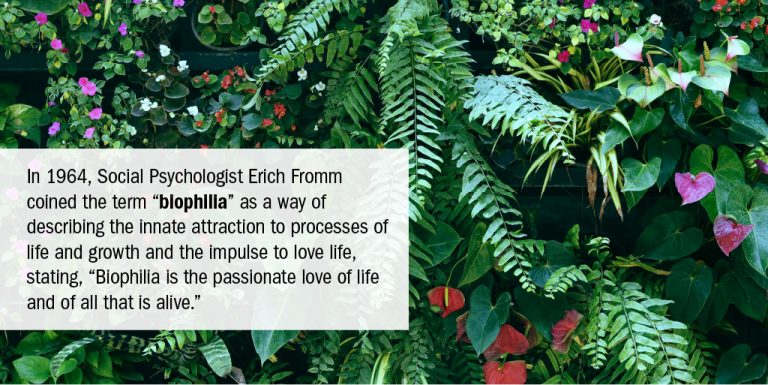
What is Biomimetics?
The term biomimicry comes from the Greek bios, meaning life, and mimesis, meaning to imitate.
Imitating nature to build products, tools and processes that can benefit everyone. Don’t look far; down feature insulation is an excellent example of biomimetics in play!
While humans have long looked to nature for inspiration, a robust methodology for biomimicry was developed and popularized in the 1990s by Jenine Benyus and colleagues. Its successful use, since that time, to develop hundreds of technologies, commercial products and processes gives the practice a level of empirical validation that is rare. Biomimetic design proceeds by observing how nature solves problems (e.g., water scarcity), abstracting a biological design principle from the observations and translating this principle into human-made technology.
Examples of biomimetic studies include fluid-drag reduction swimsuits inspired by the structure of shark’s skin, Velcro fasteners modelled on burrs, the shape of airplanes developed from the look of birds, and stable building structures copied from the backbone of turban shells. (Hwang J, 2015)
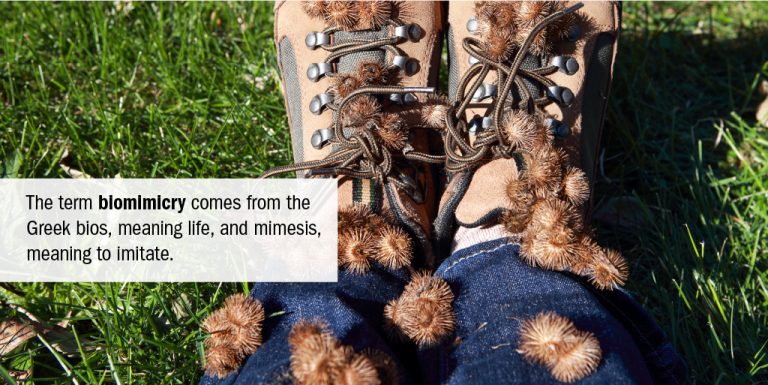
Research
“To me, research has to have a purpose. I want to ensure that my research has a path to commercialization, to come up with something that will help people as an end result. It is my desire to make the world and our ecosystem more regenerative. With my research in biophilic design, I want to be able to affect architectural design by embracing biophilia and utilizing biomimetic design in a way that benefits people, our communities and our planet. My engineering mindset helps to lead me from passion to implementation.” – Phil Fung
Clearly, all research should focus on ‘people’, says Phil. As an advocate of sustainability, bio-inspired design and regenerative design, he takes on a holistic approach.
7 Principles
“Biophilic design is inspired by nature. Nature appeals to us on several dimensions. Imitating nature, biophilic design should address these seven dimensions: physical, emotional, intellectual, psychological, social, mental health & wellbeing, and spiritual.” – Phil Fung
For example, what is the higher purpose of a building? asks Phil. His regenerative design approach focuses on the occupants. After all, without the occupants, the building is just an empty shell. He calls for the importance of expanding dialogue on the benefits of biophilic design and architecture. He rightfully notes that if people are aware of how bio-inspired design can elevate wellbeing, e.g., improve children’s learning abilities, and contribute to sustaining a so-called green building, that demand will translate to industry supply towards it.
Our homes now also serve as office spaces, schoolrooms, chat rooms, makeshift gyms, retirement homes, and more. EPA states that Americans, on average, spend approximately 90 percent of their time indoors–even more during and due to the pandemic.
“The current pandemic is not just a physical pandemic; it is also a mental pandemic. We are born with an innate connection with nature. However, urbanism has distracted us from the healing powers and positive effects of connecting with nature.” – Phil Fung
Where could research apply in this field, we asked Phil. We learnt that research directions for higher-level bio-inspired design concepts could include studying biophilic and biomimetic design methods in campus buildings, quantifying impacts on human wellness as described by the UN Sustainable Development Goals (SDG), observing impacts on learning outcomes, measuring work productivity, and so much more.
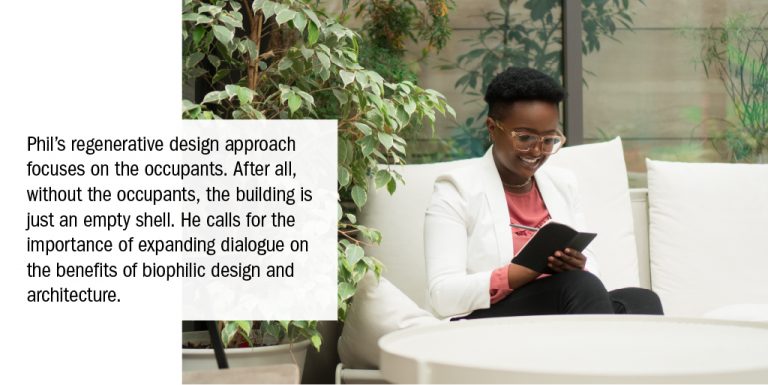
Regenerative Design
In the course of his career, Phil designed and patented his Vertical Indoor Ecosystem – Vertical Indoor Garden (VIGA™) – in early 2014, which was based on biomimetic and biophilic design principles.
“What exactly is regenerative design?” we probed. Phil had a lot to share. He states,
“When we talk about sustainability, the ultimate goal is to minimize any negative impacts on the environment, hence the widely used terms zero-carbon and zero emissions. However, we are at a point where zero impact is not enough. Recognizing the deficit in natural and environmental resources is crucial as these deficits will have devastating effects on mental health and wellbeing. Climate change is just one of the problems humankind is facing; natural resources depletion is another matter. As the world population rises, we need, for, e.g., more food. But our ecosystem is under tremendous stress already and needs time to heal, replenish and restore to produce more. We cannot continue to infuse our land with pesticides and cause not only long-term but short-term damage–polluting underground water–affecting us all. That is where regenerative design comes in.” – Phil Fung
Phil has designed an indoor food biome that uses soil, hydroponics (water) and aquaponics (fish) together with an engineered wetland to grow organic food (vegetables and fish). This can be a way to allow our farmlands and natural ecosystems to get the much-needed rest so that future generations can be provided for. This is just one example of regenerative design or what is being called a regenerative movement.
Off-Grid Brampton Humber Capstone
Keeping his students constantly involved through capstone projects is a priority for Phil. He stresses that hands-on experiential learning and exposure to community and industry needs is the only way students can truly learn. An example of Phil’s interaction with students is the Off-Grid Organic Food Shed project with the City of Brampton. Phil learned of the Brampton Backyard garden initiative through one of his students and decided to get involved. As a result, Phil conducted an Insight seminar about the Food Shed, and Humber’s students were involved in a Capstone project.
The Off-Grid Organic Food Shed is provided by Nature Harmony and is a zero-energy, zero-waste, carbon negative, greenhouse structure that will grow produce from the food shed and be donated to Regeneration Outreach Community to feed families in Brampton, as part of the 2021 Backyard Garden Program. This innovative technology contains its own ecosystem, using a combination of automated soil, hydroponics, and aquaponics systems to grow edible organic fruits and vegetables and even edible fish.
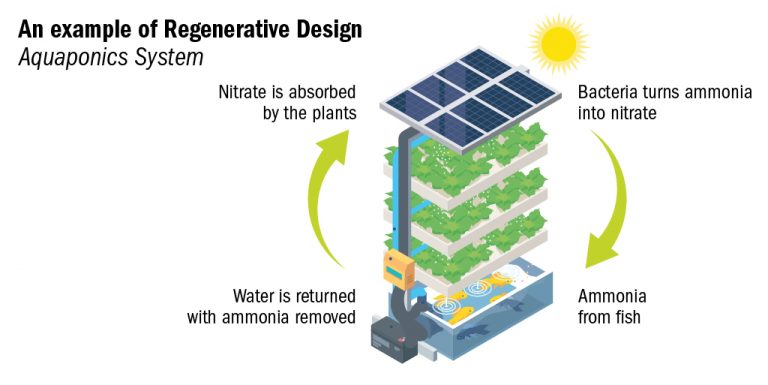
NSERC Engage Grant
Continuing his research journey, Phil holds an NSERC Engage grant ($25K) as the Principal Investigator, collaborating with Toronto-based industry partner Kirkor Architects and Planners.
Brief Summary: New post-COVID-19 and nature-based architectural solutions for enhancing personal wellness at home
Kirkor seeks novel architectural solutions to promote building occupant wellness for the “new normal” – a trend of remote working, at-home learning and at-home leisure expected to persist beyond the COVID-19 pandemic. The Humber research team will experimentally test types of acknowledged biophilic features able to be incorporated into building infrastructure (e.g., houseplants, food crops, nature imagery and aquarium fish) for their wellness-enhancing effects. Kirkor will apply these insights to developing data-supported solutions for safeguarding Canadian wellness amidst rapid changes in living and working arrangements.
Background & Expertise
Phil teaches Sustainable Building Design, Bio-inspired Buildings Design and Energy Modeling at Humber College since 2012. He also guest lectured on biomimetic design at York University and Ryerson University. In addition, Phil has been the Managing Principal of SRS Consulting Engineers Inc., ON, since 1997 (includes an R&D Centre); Executive Director of Nature Harmony Foundation that aims at responding to UN’s SDGs on environmental sustainability; and co-founder of Resilient World Institute that provides energy and sustainability training for professionals.
He has contributed to numerous publications and held various professional presentations globally; most recent, in 2021, on ‘Bio-Regenerative Building Design’ at the Royal Architectural Institute of Canada Seminar, SSAC Conference Session and Ontario Society of Professional Engineer Conference Seminar. Phil is a recognized Designated Consulting Engineer – Energy & Sustainability, LEED® Accredited Professional and Certified Sustainable Building Advisor.
Get to know Phil Fung – 5 things:
- When he’s not at work: He walks the park, spends time with his family and plays soccer.
- Inspiring book: ‘Your Brain On Nature: Become Smarter, Happier, and More Productive, While Protecting Your Brain Health for Life” by Eva M. Selhub and Alan C. Logan.
- Resource websites: Ask Nature, Biomimicry 3.8 – a Biomimicry DesignLens Visual Guide
- Design dream: An affordable, self-sustained and regenerative multi-unit residential building.
- Can we seek his advice on how to transform our homes into nature havens: YES!
“This Earth is the honey (the effect) of all beings, and all beings are the honey of this Earth.” – Brihadaranyaka Upanishad
“What I see in Nature is a grand design that we can understand only imperfectly, one with which a responsible person must look at with humility.” – Albert Einstein
References
Beatley, Tim. (2017). Biophilic Cities and Healthy Societies. Urban Planning. 2. 10.17645/up.v2i4.1054
Beynus, J. 1997. Biomimicry: Innovation Inspired by Nature. 320 pp. William Morrow Inc.
Hwang, J., Jeong, Y., Park, J. M., Lee, K. H., Hong, J. W., & Choi, J. Biomimetics: forecasting the future of science, engineering, and medicine. International Journal of Nanomedicine.
Kahn, P. H., Friedman, B., Gill, B., Hagman, J., Severson, R., Freier, N. G., Feldman, E. N., Carrere, S., & Stolyar, A. (2008). A plasma display window? The shifting baseline problem in a technology mediated natural world. Journal of Environmental Psychology, 28, 192-199.
The 17 goals. Sustainable Development. https://sdgs.un.org/goals
Backyard garden program. https://www.brampton.ca/EN/residents/parks/Pages/Backyard-Gardens.aspx#ad-image-0
Biomimicry DesignLens. Biomimicry 3.8. https://biomimicry.net/the-buzz/resources/biomimicry-designlens/
Biomimicry.org. https://biomimicry.org/the-future-of-innovation-is-here-8-inventions-from-natures-laboratory/
Biophilia and Biophobia as emotional attribution to nature in children of 5 years old. Frontiers. https://www.frontiersin.org/articles/10.3389/fpsyg.2020.00511/full
Brampton approves first off-grid organic food shed. thestar.com. https://www.thestar.com/local-brampton/news/2021/05/08/brampton-approves-first-off-grid-organic-food-shed.html
Indoor air quality. US EPA. https://www.epa.gov/report-environment/indoor-air-quality
Leveraging Biophilia through indoor living walls. Penn State Extension. https://extension.psu.edu/leveraging-biophilia-through-indoor-living-walls
‘Nature therapy’ program offered as new medical prescription to Canadians. CTVNews. https://www.ctvnews.ca/health/nature-therapy-program-offered-as-new-medical-prescription-to-canadians-1.5358112
NEO basics. Center for NEO Studies. https://cneos.jpl.nasa.gov/about/life_on_earth.html
The practice of Biophilia
Biophilia Foundation. https://www.biophiliafoundation.org/practice-biophilia/
Terrapin Terrapin Bright Green. https://www.terrapinbrightgreen.com/reports/14-patterns/img/fourteenpatterns-table.pdf
Toronto — Biophilic cities. Biophilic Cities. https://www.biophiliccities.org/toronto
